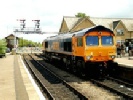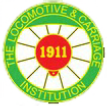By Dr M.C. Duffy
From the August 2006 Newsletter.
Petrol and oil-engined tramcars appeared in the late 19th C. Internal combustion locomotives were first tried in dockyards, on military and contractor's railways, and where steam traction was undesirable. These were of low power and limited use. Diesel traction owed much to the thermal electric principle demonstrated by J.J. Heilmann in the 1890s using locomotives which carried their own electricity generating steam plant. Heilmann's team included Durtnall, who advocated replacing the steam engine with an internal combustion motor. Between 1900 and 1920 the oil engine was put on rail. Passenger vehicles and baggage cars were equipped with petrol or oil motors for branch line work. Road vehicles were fitted with rail wheels, and a few i/c trains were constructed anew. Oil engined locomotives were relatively rare. The pioneer work in Scandanavia (c 1912), the United States (c. 1917) and Germany (c. 1914) was crucial. Direct mechanical drive to the wheels via shafts and gear boxes, sometimes with hydraulic drive, was suitable with low or moderate powers. Electric transmission was favoured for greater powers especially in the United States. General use of the diesel engine, with electric transmission, was retarded by the lack of a system to control engine, generator and traction motors working together. This was provided by Lemp in the USA.
The United States led the dieselisation of railways after 1930. In the 1920s, a considerable increase in power to weight ratio was needed for the diesel locomotive to become a general traction unit. The Winton engine company produced the motor needed. Hamilton and Dilworth, founded the Electro-Motive Company and built over 500 intercity railcars between 1924-1933. Electro-Motive was taken over by General Motors but left as an autonomous concern. During the interwar period, General Electric led diesel locomotive work and produced several noteworthy demonstrators, but lost the lead to General Motors in the 1930s. Working relationships were established between steam locomotive builders (Alco, Baldwins, Lima) the big electrical combines (Westinghouse, GE), and the makers of internal combustion prime movers (Ingersoll, GM). Development projects were controlled by big combines which had the range of engineering skills and funds. In the USA, electric transmission was standard from the start, because low voltage direct current systems dominated railway traction and street tramways. The DC motors were ideal for railway service, and the diesel locomotive in the USA used them. Multi-mode units were constructed in the 1920s, with a diesel engine, batteries, and current collection shoes and pantograph. Electric and diesel-electric locomotives used common components.
In Europe the suitability of electric transmission was questioned. Many forms of transmission were tried, including steam, air, exhaust gas, and mechanical systems. These "compound diesels" demanded radical departures from the orthodox form of oil engine. Hybrid engines, like the Still, combined the diesel cycle with steam working using an exhaust heated boiler, but failed to become established. In Russia, Lenin funded investigations by Lomonossoff into the main types of transmission, with considerable German help. He found that electric transmission was the best for transmitting work from the engine to the wheels over a wide speed range. In Russia, there was considerable theoretical analysis of locomotive thermodynamics and design, and one of the first university chairs devoted to the diesel locomotive was set up in Moscow. In Germany there was close co-operation between the railway company's research departments; technical university specialist schools, and the manufacturers' research teams. No European establishment matched the organised programme mounted by General Motors to dieselise railways. In the 1930s, several lightweight high speed passenger trains were demonstrated, powered by diesel engines, but these were not powerful enough to displace the best steam locomotives of the time.
General Motors (EMD) used motor industry lessons of marketing, manufacture, publicity, sales technique and training and applied them in launching diesel traction. Production designs were standard. Hire-purchase terms encouraged railways to accept diesels. Demonstration units were offered on loan to work prestige trains. In 1935, two 1800hp Electro-Motive units coupled together worked the Santa Fe "Super Chief" straight through from Chicago to Los Angeles. Free training of engine crew was available. Freight diesels toured North America showing their superiority to steam traction. Dependent at first on General Electric for manufacture of electrical parts, GM set up its own electrical factory to meet its locomotive needs. Independent after 1938, GM built up a lead which other manufacturers could not overtake. General Electric failed to displace the GM diesel with a steam-electric locomotive called the "Steamotive", but using its considerable resources was able to capture a fair share of the market. Other builders in the USA tried to introduce diesels of their own, but went of business in the 1950s. Post war recovery led to European railways dieselising non-electrified railways. Experiments with gas-turbine-electric locomotives; advanced diesel mechanical and hydraulic locomotives, failed to displace the diesel-electric as the best complement to electric traction. In the USA, diesel-electric traction was regarded as "cheap electrification" which avoided fixed works.
In Europe, the diesel engine became a power unit in all forms of train. The pioneer work of Kruckenberg in Germany in the 1930s, led to fast diesel trains in the post-war Benelux countries, carrying on development begun with the "Flying Hamburger". The British High Speed Train showed that diesels could work long distance express services faster than steam and could rival contemporary electric operations. Present day electric TGV operations far exceed the speed of any diesel service but the modern diesel train can regularly work at 200 km/h. In the 1930s the diesel began to displace steam and electricity in shunting. In the United States and Russia, diesels run in multiple have moved test trains of over 100,000 tonnes weight, controlled from one cab.
Electronics transformed the diesel locomotive. Components size has been reduced. Solid state rectifiers enabled the DC generator to be replaced by the smaller AC alternator. The solid state inverter and control apparatus enabled the asynchronous motor to replace the traditional DC traction motor. The globalising of industries in the 1980s led to designs for a universal diesel locomotive able to work anywhere in the world. This philosophy gave way to the modular policy of building diesel and electric units, from heavy goods engines to TGV using common components. European companies are co-operating with North American combines to produce global designs. GM diesel-electric locomotives made in North America are at work in Europe. The diesel locomotive continues to develop. Driverless working has been demonstrated. Experiments to operate diesel locomotives off hydrogen, coal-based fuels, methane and other gases, and coal-slurry have been carried out. Though it cannot match the very high performance of the electric locomotive, the diesel is ideal for all operations outside electrified zones.



